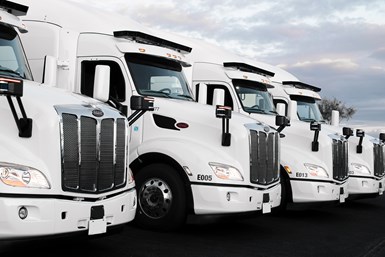Addressing Automation for Commercial Applications
Self-driving ride-hailed vehicles may seem cool, but autonomous commercial vehicles may actually be a better deployment of the technology
#economics #robotics #electronics
Although there is considerable attention to the potential of autonomous vehicles (AVs) being used for people transport (e.g., Lyft, Uber; Waymo has its autonomous Pacificas rolling around in Chandler, AZ), according to equity analyst and auto observer Colin Langan, it very well may be that automated delivery may be a better approach for companies involved in development and execution of the technology.

Trucks in the fleet of TuSimple, a self-driving technology company focused on commercial vehicles. (Images: TuSimple)
Langan, speaking during a Society of Automotive Analysts webinar, said that there are three primary reasons this is the case. One is that there are lower technology barriers to move potatoes rather than people; another is the size of the market is huge (~$1.5-trillion); and finally, there are superior economics for goods delivery compared to ridesharing.
Delivering the Goods
As to the point of the lower tech barriers, Langan said that one of the challenges of developing AVs for people is achieving a comfortable ride, not a jerky one, which is difficult to achieve, particularly in early instances of the AV tech. That is not an issue for goods delivery, where smoothness of the transport doesn’t much matter to bags of potatoes.
The New Yorker said: Look in the back seat of a given cab in Manhattan; it may be rather. . .messy. What would be the condition of the interior of an AV when there is no one in the front seat at least making sure things aren’t too bad in the rear (and this is not taking into account post-COVID-19 considerations of hygiene for personal transport)?
When people are in vehicles, they are more interested in getting somewhere quickly and they often travel when other people are doing the same thing.
For commercial goods, if there are flexible delivery windows, then timing is not a concern. This has several potential benefits. For example, if there are deliveries in the middle of the night, this reduces overall congestion.
Blue Highways
While developing AVs for urban environments is challenging, Langan said that highway driving can be more readily accommodated. (Think, for example, of the Cadillac Super Cruise system, which was originally developed for use on divided highways—same sort of thing.) What’s more, it is possible, Langan said, that commercial vehicles could be routed on back roads, where they would drive more slowly, thereby providing the AV system with more response time.
With regard to economics, he said there are savings to be achieved through the elimination of delivery drivers as well as a higher utilization cost compared to an autonomous rideshare vehicle.
While commercial deliveries may not garner the attention of self-driving taxis, Langan said that the companies that pursue it can get to market more quickly, generate revenue faster, and have the opportunity to gain a sustainable advantage through scale.
Take the COVID-19 likelihood of people being less inclined to take shared vehicles of any type and the pursuit of AVs for people moving is going to make it all the more difficult for the companies working in that area.
With the rise of e-commerce and deliveries of all types occurring during the pandemic, the upside for commercial AVs seem a whole lot better.
RELATED CONTENT
-
VW Warns of Higher Costs to Develop EVs
CEO Herbert Diess says the €20 billion ($23 billion) Volkswagen AG has budgeted to electrify its entire vehicle lineup won’t be enough to meet that goal.
-
On Global EV Sales, Lean and the Supply Chain & Dealing With Snow
The distribution of EVs and potential implications, why lean still matters even with supply chain issues, where there are the most industrial robots, a potential coming shortage that isn’t a microprocessor, mapping tech and obscured signs, and a look at the future
-
On Lincoln-Shinola, Euro EV Sales, Engineered Carbon, and more
On a Lincoln-Shinola concept, Euro EV sales, engineered carbon for fuel cells, a thermal sensor for ADAS, battery analytics, and measuring vehicle performance in use with big data


.jpg;width=70;height=70;mode=crop)






